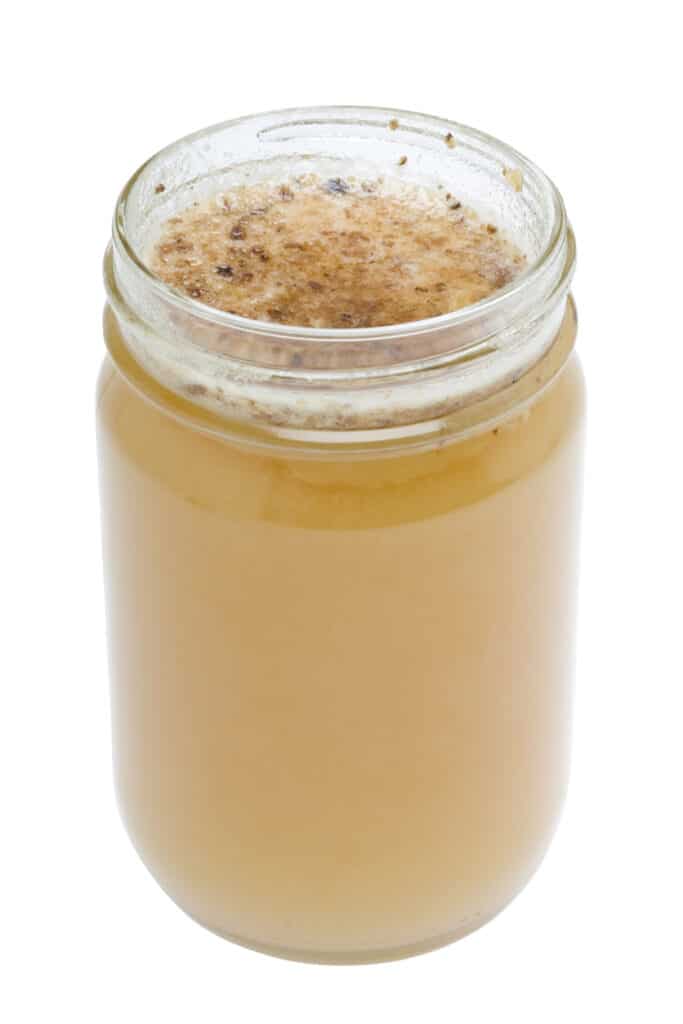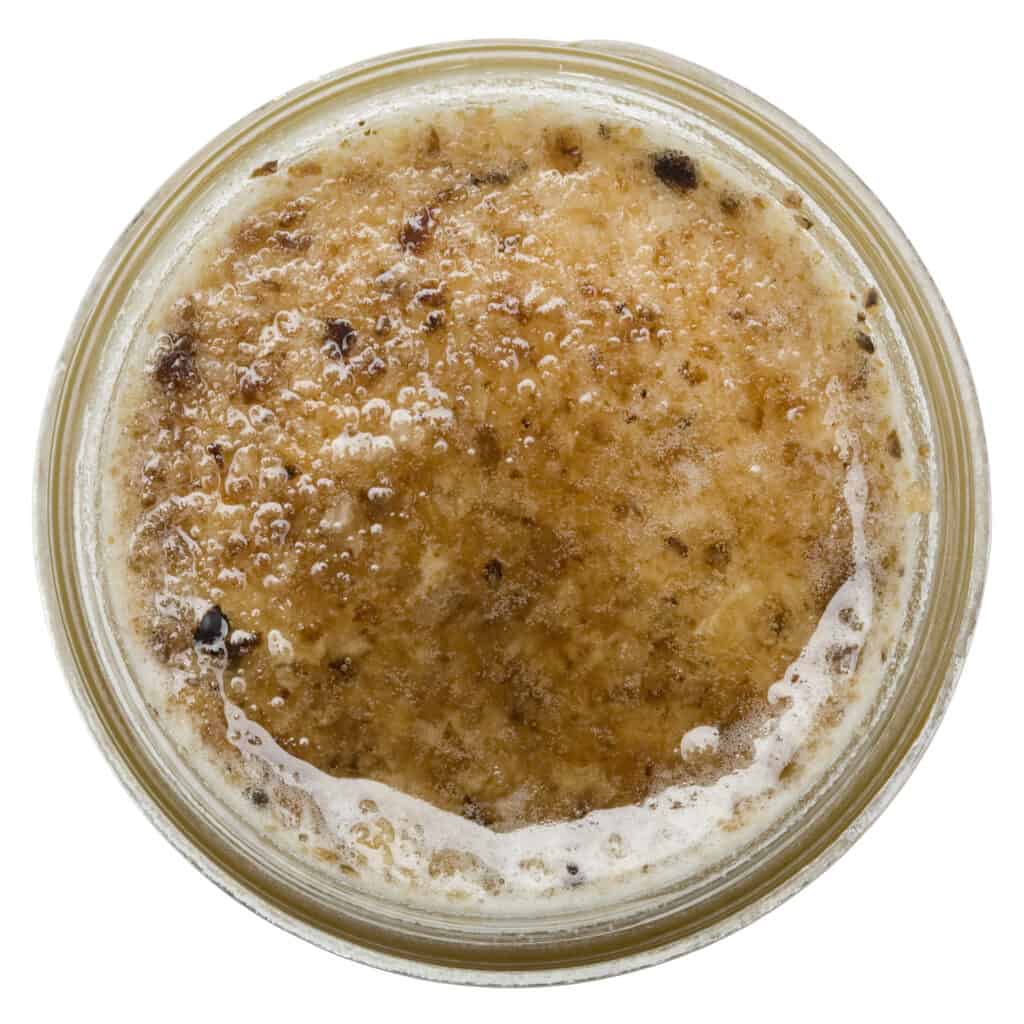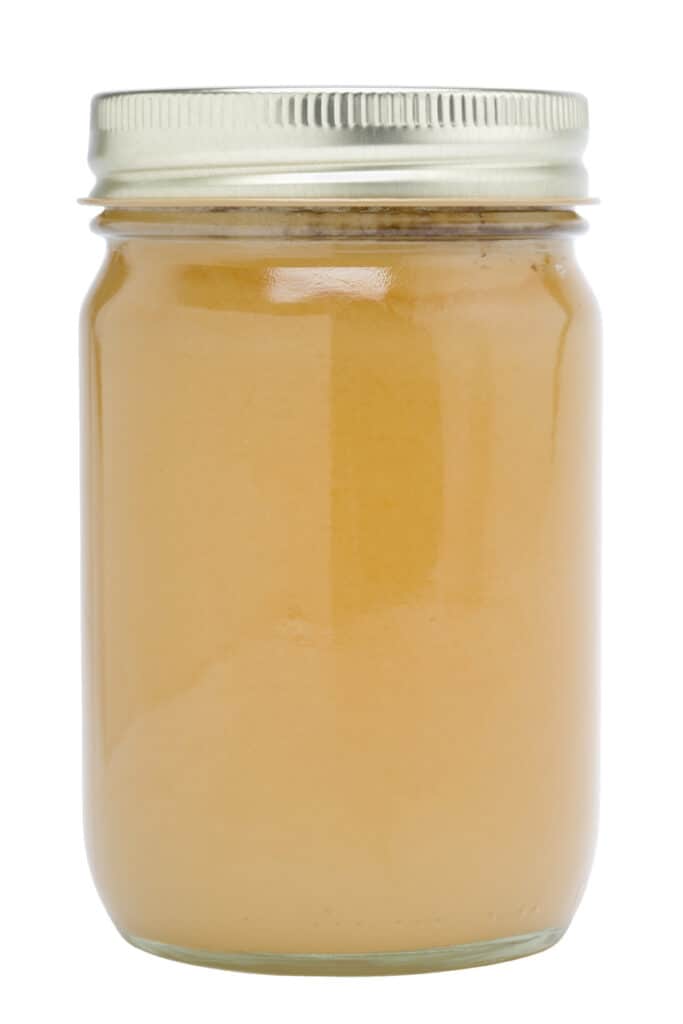I remember the wonderful taste of thick, sweet honey on my breakfast pancakes when I was a young child. And even now that I am an adult, nothing beats the taste of honey on a slice of warm toast. When shopping for honey, I am sure you have been amazed at the different bottles and jars of honey on the store shelf. Which do you ultimately choose, and what is unfiltered honey?
Unfiltered honey is raw honey extracted from the honeycomb and strained to remove impurities. Unfiltered honey is not heated or processed like filtered honey. It is safe for consumption by humans over the age of 1 year. Unfiltered honey is pure if the jar is labeled 100% raw and unfiltered.

Read on for more about the process, the properties, and benefits of unfiltered honey and how to store it. There are some interesting facts on why unfiltered honey has a long shelf-life and more about the culinary uses of this delicious product.
Processing Unfiltered Honey

The clever bees make the delicious honey and store this in honeycombs sealed with wax. Beekeepers remove the combs from the hive and remove this wax. A machine is used to spin the comb to extract the honey.
The honey is filtered, which means that all impurities such as pieces of wax or bee parts that were in the combs are removed. Because unfiltered honey is less processed than filtered honey, it may still contain some wax and pollen particles. Unfiltered honey is not heat processed like filtered honey.
Is Unfiltered Honey The Same As Raw Honey?

Raw honey is the same as unfiltered honey. But only if the unfiltered honey has not been processed or heated. Unfiltered honey is only strained to extract the pieces of wax or other impurities left over from extracting the honey from the combs.
When you purchase a jar of unfiltered honey, be sure to read the label. It should state that the honey is 100% raw and unfiltered.
Is It Safe To Eat Unfiltered Honey?
Unfiltered honey is safe for the average person to eat. But babies under 12 months should not have any honey in their diet. A baby’s digestive tract has not yet developed to fight off any bacteria found in honey. Honey does contain a very tiny amount of bacteria called Clostridium botulinum, but this will not have an effect on the majority of people.
Nutritional Facts Of Unfiltered Honey
Unfiltered honey is a pure natural food and is much more than just a natural sweetener. When you use honey as a substitute for sugar, you use less honey as it has a sweeter taste than sugar.
A tablespoon of unfiltered honey contains:
- Calories: 64
- Protein: 0 grams
- Fat: 0 grams
- Carbohydrates: 17 grams
- Fiber: 0 grams
- Natural Sugars (fructose and glucose): 17 grams
Unfiltered honey also contains trace quantities of vitamins and minerals such as:
- Iron
- Zinc
- Potassium
The Benefits Of Unfiltered Honey?
Unfiltered honey has many nutrients and health benefits. However, it is always recommended to consult a doctor if you use honey to treat or alleviate health symptoms. Below are some of the benefits of unfiltered honey.
Unfiltered Honey Is A Natural Energy Source
Unfiltered honey contains 80% natural sugars (parts of fructose and glucose),18% water, and 2% protein, vitamins, minerals, and pollen. It supplies energy in the form of liver glycogen and is ideal for taking before exercising. Unfiltered honey is often included in some of the best pre-workout snacks and meals.
Unfiltered Honey Boosts The Immune System
Scientists have proven that taking a daily dose of honey raises the level of antioxidants in the body. These antioxidants help block the body’s free radicals that cause diseases.
Unfiltered Honey Promotes Weight Loss And Aids Diabetes
Replacing unfiltered honey with sugar helps to prevent packing on extra weight. Unfiltered honey lowers the serum triglycerides, a type of fat found in the blood. A study has also found that unfiltered honey activates hormones that suppress appetite.
Unfiltered honey increases insulin and decreases hyperglycemia. Add some cinnamon to the honey to counteract the glucose elevation in honey, creating a low glycemic energy food combination.
Unfiltered Honey Counters Pollen Allergies
Regularly eating unfiltered honey can make your body less sensitive to symptoms of seasonal allergies. The pollen in the honey is obtained by the bees when they visit different flowers. These are the flowers that cause you to have seasonal allergies. When you consume the honey, you become less sensitive to the pollen causing the allergies.
Unfiltered Honey Promotes Sleep
Having some honey before bedtime will restock the liver’s glycogen supply so the brain will not trigger the body to search for food, causing you to wake up. Add a tablespoon of unfiltered honey to a glass of warm milk and drink this before bedtime.
Unfiltered Honey Heals Wounds And Ulcers
Unfiltered honey is a natural antibacterial, so using honey-infused bandages on wounds promotes healing. The honey reacts with the body’s fluids creating low concentrated hydrogen peroxide, which is an inhospitable environment for bacteria. A study has shown that unfiltered honey helps to reduce the size, pain, and odor of skin ulcers.
Unfiltered Honey Relieves A Cough And A Sore Throat
Add a teaspoon of unfiltered honey to tea, or you can eat the honey to relieve mucus secretion and coughs. You can use this for children over the age of 1 year.
How To Store Unfiltered Honey?
Unfiltered honey can be stored in a cupboard for a long time. Here are some tips for long-term storage.
- Store the unfiltered honey at an approximate room temperature (between 70 and 80°F (21 to 27°C).
- Unfiltered honey should not be refrigerated.
- Storing the honey in a dark place will better retain the consistency and flavor.
- Keep the honey sealed after use and keep it clean by removing any bits of food chunks.
- If the unfiltered honey crystallizes in the jar, heat the container in a pot of warm water.
- Unfiltered honey kept for a long time will naturally become darker, and the taste may change.
You can successfully store unfiltered honey, but if mold grows, do not eat it. Mold can happen if food particles are left in the jar.
What Is The Shelf Life Of Unfiltered Honey?
Although archeologists have found jars of honey that are thousands of years old and still well preserved, in modern times, it is safe to store unfiltered honey for up to 12 months. However, the honey will be safe to eat, but the quality may not be as good. It will become cloudy, crystalized, or solidified.
To clarify or melt the unfiltered honey, you can microwave it for a few seconds or heat the container in a pan of hot water.
Why Can Unfiltered Honey Be Stored For A Long Time?
Unfiltered honey is a sugar that contains very little water in its natural state (hygroscopic). But if the honey is unsealed, it can absorb moisture. Unfiltered honey’s natural form of low moisture is detrimental to bacteria and micro-organisms, which do not survive in this environment. This is the main reason why unfiltered honey does not spoil, as no organisms will survive to do any damage.
Another reason is that unfiltered honey is extremely acidic, with its pH falling between 3 and 4.5, which is not conducive to any organism’s survival.
While this is all very scientific, let’s not forget the ingenious way the beautiful and clever bees make honey. So, what do bees use to make honey that is so special?
- Nectar – is the first of nature’s products the bees use. When this nectar is first collected, it contains about 60 – 80% water. During the process of making the honey, the bees remove most of this moisture by flapping their wings to dry the nectar.
- Hydrogen Peroxide – When bees regurgitate nectar from their mouths into the combs to make honey, they release an enzyme from their stomachs. This enzyme, glucose oxidase (PDF), breaks the nectar into 2 products, gluconic acid, and hydrogen peroxide.
As previously mentioned, the hydrogen peroxide works against any bacteria that could possibly grow in the honey.
The Different Tastes Of Unfiltered Honey
Have you ever wondered why bottles of honey taste different? Well, the taste, color, and texture of unfiltered honey are determined by the type of flowers from which honeybees collect nectar and pollen. Bees will forage from any flowers that are close to the hive. When the bees make the honey, some of the pollen gets trapped.
The pollen adds to the characteristics of honey. It is also the traceable ingredient that can indicate from which flowers the bees collected the nectar. Most unfiltered honey bought from a store is a blend of honey from different hives. These bees would have visited many flowers near their hive.
However, some unfiltered honey is known as ‘univarietal,’ such as blueberry honey. This is achieved by placing the hives close to an area where only one type of plant will bloom. Bees will predominantly (45%) collect nectar and pollen from these plants, and the honey they produce will have a distinct flavor.
Bees will forage resin from tree trunks to seal the hives. When the bee’s mouth makes contact with the resin, it is known as propolis. This propolis seal is opened by the beekeeper when retrieving the honey. Sometimes this propolis will get into the honey, and a light pine or nutty taste will be added to the flavor profile of the honey.
The next time you buy a jar or bottle of unfiltered honey, appreciate the honey’s characteristics and try to determine the flavor. Here is how to do this:
- Hold the unfiltered honey to the light and look at the color. Does it remind you of light walnut or dark chocolate?
- Does the honey smell citrusy or sweet and florally? What does it remind you of?
- Is the consistency thick and smooth or clear and runny? Tropical kinds of honey tend to be clear and runny due to the high humidity in those regions. Whereas desert wildflower honey is thicker and smoother.
- Finally, taste the honey. Pour half a teaspoon onto a spoon and allow the honey to melt on your tongue. Determine if the honey tastes bright and sharp or warm and super-sweet. Breathe through your nose; this will heighten the taste experience.
- See if you can pick up tastes like caramel, burnt caramel, hazelnut, lemon, or lemon rind.
Enjoy this tasting experience with your family; you might be surprised at what their tastebuds will reveal.
Culinary Uses For Unfiltered Honey
Unfiltered honey is a versatile ingredient and is a healthy way to add sweetness to your food and drinks.
Unfiltered Honey As A Sweetener
Add a teaspoon of delicious unfiltered honey to drinks like tea, smoothies, lemonade, or warmed milk. Unfiltered honey is a delight drizzled on pancakes, toast, oatmeal, scones, and fruit salad.
Cooking With Unfiltered Honey
Add unfiltered honey to your roasted vegetables for a special treat. When drizzling on the olive oil, drizzle some unfiltered honey over the vegetables. This recipe is delicious for roasting carrots, sweet potatoes, beets, butternut, and parsnips.
Unfiltered Honey Pairs Well With Cheese
Adding unfiltered honey to your charcuterie board is pure decadence. The honey balances and complements the flavor of the savory cheese. It is best served with cheeses like Ricotta, Brie, Blue, and Parmigiano.
Unfiltered Honey For Marinating And Glazing
Keep your meat and seafood moist by adding some unfiltered honey into the marinating sauce. The vinegar or lime juice acts as the tenderizer and combined with the honey, this magical pairing will add flavor and lock in the moisture.
Unfiltered honey is delicious with ham. Add some honey to brown sugar, orange juice, cinnamon, cloves, and nutmeg to make a gorgeous honey glaze for baked ham.
Conclusion
Unfiltered honey is honey taken from the hive, put through a sieve to remove any particles such as wax, and then bottled. This honey is not processed or heated. When purchasing a jar of unfiltered honey, ensure the label states that it is 100% raw and unfiltered.
References
https://www.smithsonianmag.com/science-nature/the-science-behind-honeys-eternal-shelf-life-1218690/

